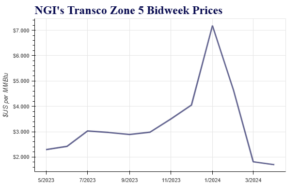‘Modestly Constructive’ EIA Print, but August Natural Gas Continues Lower Early
With the market continuing to weigh widespread hot temperatures this month against signs of looseness in the underlying supply/demand balance, natural gas futures were down slightly in early trading Friday. The August Nymex contract was off 1.5 cents to $1.708/MMBtu at around 8:45 a.m. ET.

The U.S. Energy Information Administration (EIA) on Thursday reported an injection of 45 Bcf into Lower 48 gas stocks for the week ending July 10. The build was lower than the 56 Bcf injection for the week ended July 3 and slightly below analysts’ average expectations.
The latest result compares with a 67 Bcf storage build in the same week in 2019 and a five-year average injection of 63 Bcf. The 45 Bcf build lifted inventories to 3,178 Bcf, well above the year-earlier level of 2,515 Bcf and above the five-year average of 2,742 Bcf.
“Although the EIA print was modestly constructive, once it was out of the way the bears took over and gas finished the day down around 3%,” analysts at Tudor, Pickering, Holt & Co. (TPH) said. “This week’s 45 Bcf build confirmed our bearish near-term stance as it implies a roughly 1.5 Bcf/d oversupplied market on a weather-adjusted basis.
“The build was well below seasonal norms of 60 Bcf but benefited from record heat, which drove degree days 13% above norms.” This “continues a stretch of impressive weather that shows cumulative degree days 11% above the five-year for the current injection season.”
The current storage trajectory could present a problem for the bulls if hot weather can’t sustain itself.
“Without strong weather demand, inventories likely continue to expand versus the five-year and set up for a capacity crunch this fall,” the TPH analysts said.
Looking at the guidance, Bespoke Weather Services said in a note to clients early Friday its latest forecast remained roughly unchanged day/day.
“Weather remains bullish in terms of a sustained hotter than normal pattern, which we feel continues on into August, but even in this hotter regime, models have had a tendency to over forecast the level of heat in the medium range, so we erred on the cooler side of guidance once again today,” Bespoke said. “…The next week to 10 days, in absolute terms, look to be the peak of our summer heat, nationally.”
On the exports front, the month of July has brought weak liquefied natural gas (LNG) feed gas demand. Genscape Inc. estimates showed volumes dropping 1.1 Bcf/d on July 1, down from 4.2 Bcf/d to 3.1 Bcf/d.
“Since then, LNG feed gas demand has remained depressed, averaging only 3.1 Bcf/d since the start of the month,” Genscape analyst Preston Fussee-Durham said. “While feed gas demand reached a low of 2.8 Bcf/d on July 9, demand has begun to rebound in recent days. Yesterday, feed gas demand from LNG facilities climbed 200 MMcf/d day/day to reach monthly highs of 3.4 Bcf/d, primarily led by an uptick in liquefaction operations at Cameron LNG.”
Genscape’s estimate for Friday’s LNG demand remained unchanged at close to 3.41 Bcf/d, the analyst said.
August crude oil futures were down 20 cents to $40.55/bbl at around 8:45 a.m. ET, while August RBOB gasoline was off fractionally to $1.2256/gal.
© 2024 Natural Gas Intelligence. All rights reserved.
ISSN © 1532-1231 | ISSN © 2577-9877 |


